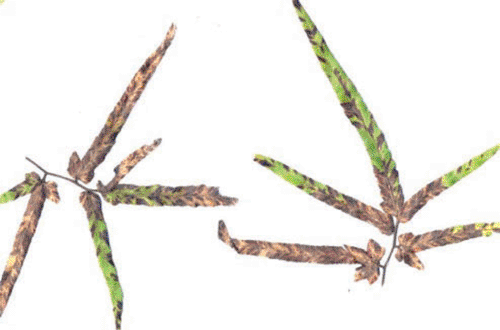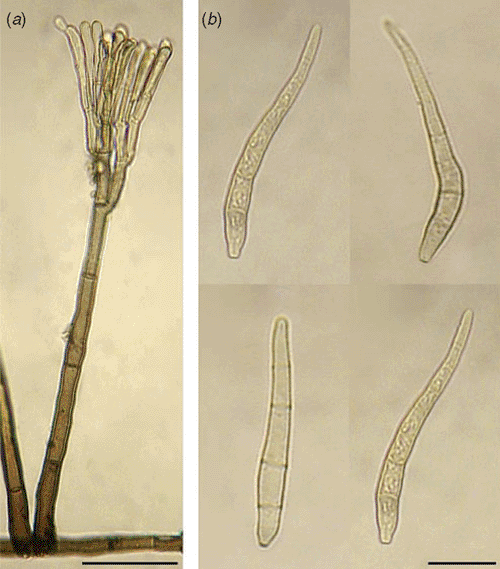First record of Periconiella lygodii occurring on Lygodium japonicum in the Philippines
M. Mahamuda Begum A , R. G. Shivas B and C. J. R. Cumagun A CA Crop Protection Cluster, College of Agriculture, University of the Philippines Los Baños, College, Laguna 4031, Philippines.
B Plant Pathology Herbarium, Department of Primary Industries and Fisheries, 80 Meiers Road, Indooroopilly, Qld 4068, Australia.
C Corresponding author. Email: christian_cumagun@yahoo.com
Australasian Plant Disease Notes 4(1) 17-18 https://doi.org/10.1071/DN09007
Submitted: 4 February 2009 Accepted: 12 February 2009 Published: 2 March 2009
Abstract
This is the first report of Periconiella lygodii, which causes leaf spot on the fern Lygodium japonicum, from the Philippines. It was found at several sites near Los Baños, Laguna Province in 2008.
Introduction
Lygodium is a genus of climbing fern (Pteridophyta) with ~40 species, which are mostly native to tropical regions across the world. Japanese climbing fern (Lygodium japonicum (Thunb.) Sw.) is native to southern and eastern Asia, including China, Japan, India, the Philippines and Papua New Guinea. It has been reported as a weed in the Philippines and Taiwan (Holm et al. 1979) as well as in the USA (Langeland and Burks 1998). Japanese climbing vine forms tangled masses that can kill shrubs and ground cover by shading and smothering them.
Diseased leaflets of L. japanicum were collected from plants growing at the University of Philippines Los Baños, College, Laguna Province during 2008. Associated with these leaf spots was a fungus, which matched the description and illustration of Periconiella lygodii A. Singh, K. Bhalla & S.K. Singh ex Braun (2004), which is a pathogen of Lygodium in India (Singh et al. 1998). This is the first record of P. lygodii in the Philippines.
Host symptoms and fungal morphology
Braun (2004) has given a detailed description of the host symptoms and excellent line drawings of the conidiophores, conidiogenous cells and conidia of P. lygodii. The following description is largely based on Braun (2004) supplemented by photomicrographs taken from the Los Baños specimens.
Leaf spots found on both leaf surfaces, up to 1 cm long, subcircular to angular-irregular, oblong or diffuse, at first yellowish to medium dark brown, later grayish brown or grey, margin indefinite, often vein-limited (Fig. 1). Colonies hypophyllous, dark brown. Mycelium internal and external. Stromata lacking or with a few brown swollen hyphal cells. Conidiophores solitary or in groups of two or three, emerging through stomata or arising from superficial hyphae, medium to medium-dark brown, thick-walled, multiseptate, straight, 90−350 µm long, smooth-walled, branched apical portion, two to four times dichotomously or occasionally trichotomously branched, dense, branchlets up to 50 µm long and 2−5.5 µm wide; conidiogenous loci conspicuous, often numerous, apically aggregated, circular, darkened-refractive, unthickened or slightly thickened (Fig. 2a). Conidia solitary, obclavate-cylindrical, subhyaline to very pale olivaceous or olivaceous brown, 25–75 × 3−5.5 µm, 1−5-septate, smooth, apex obtuse or subobtuse, base obconically truncate, 1−2 µm wide, hila unthickened, not darkened or slightly darkened-refractive (Fig. 2b).

|

|
Four species of Periconiella have been reported to occur on ferns (Braun 2004). These are P. benkertii (on Polypodium sp.), P. cyatheae (on Cyathea macgillivrayi), P. lygodii (on Lygodium spp.) and P. rhachidicola (on Polypodium sp.).
Braun (2004) noted that P. lygodii is distinguished from all other species of Periconiella on ferns by having long, obclavate-cylindrical, pluriseptate, smooth conidia. Voucher specimens were deposited as CALP 11680 (Mycological Herbarium, University of the Philippines Los Baños, College Laguna, Philippines) and BRIP 52369 (Plant Pathology Herbarium, Queensland Department of Primary Industries and Fisheries. Indooroopilly, Australia). This is the first record of P. lygodii on Lygodium japonicum in the Philippines. The potential for P. lygodii as a biological control agent for weedy Lygodium is not known.
Braun U
(2004)
Periconiella species occuring on ferns. Feddes Repertorium 115, 50–55.
| Crossref | GoogleScholarGoogle Scholar |

Singh A,
Bhalla K, Singh SK
(1998) Three phytoparasitic species of Periconiella from Indian sub-continent. Indian Phytopathology 51, 30–35.



